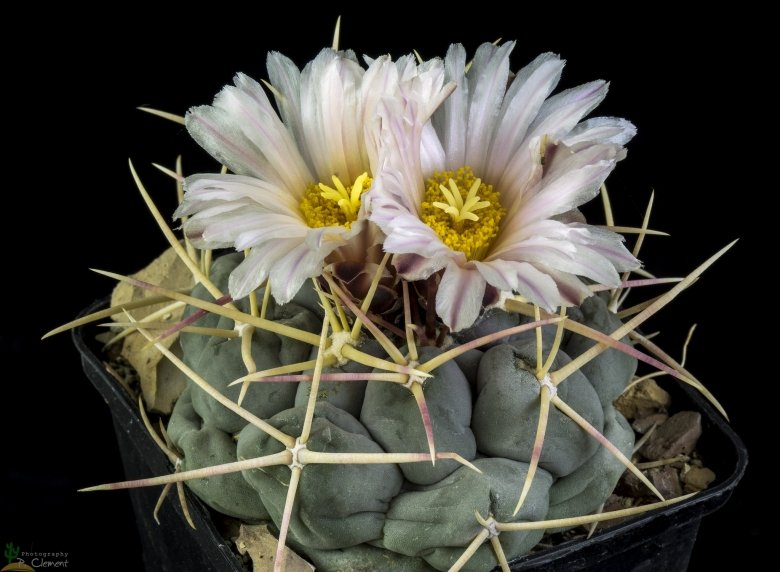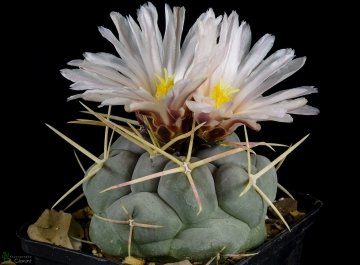Donate now to support the LLIFLE projects.
Your support is critical to our success.
Your support is critical to our success.
Thelocactus hexaedrophorus var. droegeanus
Thelocactus (Cactus File Handbook, 1) 29 (1996) Basionym not stated. (Hildm.ex K.Schum.)
Family: CACTACEAE
Thelocactus (Cactus File Handbook, 1) 29 (1996) Basionym not stated. (Hildm.ex K.Schum.)
Family: CACTACEAE
Accepted Scientific Name: Thelocactus hexaedrophorus (Lem.) Britton & Rose
Bull. Torrey Bot. Club 1922, xlix. 251

Thelocactus hexaedrophorus var. droegeanus Photo by: Peiffer Clement
Synonyms:
- Thelocactus hexaedrophorus var. droegeanus (Hildm. ex K.Schum.) Pilbeam
- Echinocactus droegeanus Hildm. ex K.Schum.
- Echinocactus hexaedrophorus var. droegeanus Schelle
See all synonyms of Thelocactus hexaedrophorus
back
Accepted name in llifle Database:Thelocactus hexaedrophorus (Lem.) Britton & Rose
Bull. Torrey Bot. Club 1922, xlix. 251
Synonymy: 26
- Thelocactus hexaedrophorus (Lem.) Britton & Rose
- Echinocactus hexaedrophorus Lem.
- Thelomastus hexaedrophorus (Lem.) Frič in Kreuz.
- Echinocactus hexaedrophorus roseus Lem.
- Thelocactus hexaedrophorus var. decipiens (A.Berger) Pilbeam
- Thelocactus hexaedrophorus var. droegeanus (Hildm. ex K.Schum.) Pilbeam
- Echinocactus droegeanus Hildm. ex K.Schum.
- Echinocactus hexaedrophorus var. droegeanus Schelle
- Thelocactus hexaedrophorus var. fossulatus (Scheidw.) Backeb.
- Echinocactus fossulatus Scheidw. in Otto & A.Dietr.
- Echinocactus hexaedrophorus var. fossulatus (Scheidw.) Salm-Dyck ex Labour.
- Echinocactus hexaedrophorus f. fossulatus (Scheidw.) Voss in Vilm.
- Thelocactus fossulatus Britton & Rose
- Thelocactus hexaedrophorus subs. franci Halda & Sladk.
- Thelocactus hexaedrophorus subs. jarmilae Halda & Chvastek
- Thelocactus hexaedrophorus subs. kvetae Chvastek & Halda
- Thelocactus hexaedrophorus var. labouretianus (K.Schum.) Pilbeam
- Echinocactus hexaedrophorus var. labouretianus K.Schum.
- Echinocactus hexaedrophorus f. labouretianus (K.Schum.) Schelle
- Echinocactus labouretianus Cels ex K.Schum.
- Thelocactus hexaedrophorus var. major (Quehl) Y.Itô
- Echinocactus hexaedrophorus var. major Quehl
- Echinocactus hexaedrophorus f. major (Quehl) Schelle
- Thelomastus hexaedrophorus major (Quehl) Frič in Kreuz.
- Thelocactus hexaedrophorus var. paradensis Pilbeam
Thelocactus hexaedrophorus subs. lloydii (Britton & Rose) N.P.Taylor
Cactaceae Consensus Init. 5: 14. 1998
Synonymy: 5
- Thelocactus hexaedrophorus subs. lloydii (Britton & Rose) N.P.Taylor
- Thelocactus hexaedrophorus var. lloydii (Britton & Rose) Kladiwa & Fittkau
- Thelocactus lloydii Britton & Rose
- Thelocactus hexaedrophorus subs. lloydii f. major
- Thelocactus hexaedrophorus var. fossulatus cv. Long spines (Japan) (Scheidw.) Backeb.
- Thelocactus hexaedrophorus subs. lloydii cv. monstruosus
back

Thelocactus hexaedrophorus var. droegeanus Photo by: Peiffer Clement
Send a photo of this plant.
The gallery now contains thousands of pictures, however it is possible to do even more. We are, of course, seeking photos of species not yet shown in the gallery but not only that, we are also looking for better pictures than those already present. Read More...
The gallery now contains thousands of pictures, however it is possible to do even more. We are, of course, seeking photos of species not yet shown in the gallery but not only that, we are also looking for better pictures than those already present. Read More...
| Your Actions | |
|---|---|
| Back to Thelocactus index | |
| Back to Cactaceae index | |
 |
Back to Cacti Encyclopedia index |








